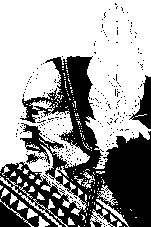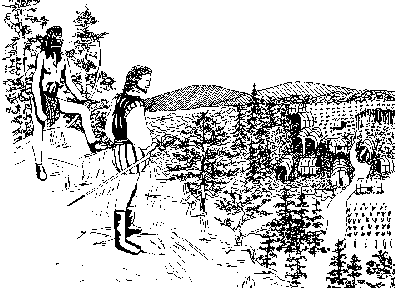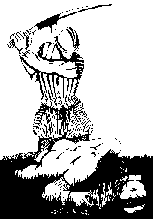
Donald E. Sheppard is a fifth generation Floridian. Don has been fascinated with Spanish Conquistadors since age ten. An Engineer, Scientist and Retired Officer of the U.S. Navy, he has studied Hernando de Soto's route for thirty years. Don has visited all of the sites DeSoto's people described while consulting Universities, Museums, Historians, and ordinary people along DeSoto's way through fourteen of our States.
Jeremiah Wolfe is a fiftieth generation North Carolinian, Jerry is a full-blooded Member of the Eastern Band of Cherokee. A Merchant, Mason, Honorable Veteran and Christian, he knows and recites oral traditions of his Tribe. Jerry knows the language of his ancient relatives and is familiar with all of the places which Desoto's people named in the Cherokee Mountains and with what they did and caused there.

At the base of the Great Smoky Mountains live a people whose ancestors came to America thousands of years before Columbus. Ancient tribes followed large animals over a land bridge from Asia when the seas had frozen into glaciers during the last Ice-age, making the oceans shallow. Tribes hunted the large animals with stone tipped spears, then roasted their meat over fires in coastal caves and rustic abodes. Hides were used for clothing, shoes and blankets. Clans moved down the shorelines with the animals and gathered wild fruits and vegetables along the way. Fire was carried from place to place. Fish were caught and sea shells were used for knives, tools and utensils. Colorful feathers, gems and shells were strung with animal hide and worn for identity.
 When
our climate got warmer the glaciers melted, the oceans rose, smaller animals
prevailed and people moved inland with the oceans. Tropical currents flowed
into the Gulf of Mexico, causing rains which kept the Mississippi River
full year round. Fish and migratory animals ate the foods which grew near
the river's bottom lands and thousands of people settled the Mississippi
River. They fanned up its feeders as the climate got warmer. Various clans
gathered to form villages to protect themselves from others and wild animals.
Some in the villages fished, others hunted, some made blankets and clothes
from plants and animals, and others gathered wild fruits and vegetables.
Pottery was made from clay and seeds were planted in fertile places along
the rivers. Houses were made with wood and covered to keep them dry. Fire
places were built and used to smoke fish and meat for the winter. Crops
were gathered and stored in dry places.
When
our climate got warmer the glaciers melted, the oceans rose, smaller animals
prevailed and people moved inland with the oceans. Tropical currents flowed
into the Gulf of Mexico, causing rains which kept the Mississippi River
full year round. Fish and migratory animals ate the foods which grew near
the river's bottom lands and thousands of people settled the Mississippi
River. They fanned up its feeders as the climate got warmer. Various clans
gathered to form villages to protect themselves from others and wild animals.
Some in the villages fished, others hunted, some made blankets and clothes
from plants and animals, and others gathered wild fruits and vegetables.
Pottery was made from clay and seeds were planted in fertile places along
the rivers. Houses were made with wood and covered to keep them dry. Fire
places were built and used to smoke fish and meat for the winter. Crops
were gathered and stored in dry places.
Villages united into networks bordered by natural barriers. Dugout canoes were invented and networks enlarged into nations of people who shared certain customs and gestures. Culture grew rapidly with the exchange of news, foods, clothing, metals, and art. The Cherokee Indians, the Tennessee River people, became one of the nations residing along the Great River System; the Mississippi and all of its giant tributaries. Other nations were forming along the Great River's other tributaries: the Ohio, the Missouri, the Arkansas and the Red Rivers. Trade was conducted along the Great River from the Rockies to the Appalachians and down to the Gulf of Mexico. Large cities grew where the big tributaries merged. Indian economy focused into the continent, with Illinois at the center of trade, not outward across the seas, as was the habit of European nations at the time Columbus discovered America.
 The
Cherokee Indians lived along the Tennessee River in the Appalachian Mountains.
They thrived in the bottom lands from Virginia southward. They built their
houses in villages, much like Early American settlers did. Villages were
separated by day-long walks, houses were made of wood and stone, fields
were planted, nuts and berries were gathered, game was cured, tobacco was
smoked and the Cherokee people adhered to high ethical standards. "Fire,"
the center of life, became the Cherokee word for "home."
The
Cherokee Indians lived along the Tennessee River in the Appalachian Mountains.
They thrived in the bottom lands from Virginia southward. They built their
houses in villages, much like Early American settlers did. Villages were
separated by day-long walks, houses were made of wood and stone, fields
were planted, nuts and berries were gathered, game was cured, tobacco was
smoked and the Cherokee people adhered to high ethical standards. "Fire,"
the center of life, became the Cherokee word for "home."
 Rivers
between the Cherokee mountains, fed by creeks running from all directions,
flowed north and west into the Great River, the Cherokees' lifeline to
other Indian cultures. A network of roads followed those rivers and streams
to connect the Cherokee villages. Steep mountain gaps limited routing choices
so Cherokee roads converged at certain gaps, just as roads do today in
those mountains. Village chieftains lead and represented the people to
the tribe as a whole. The people used the roads to trade and compete with
other villages. They continued to grow and flourish well after Columbus
discovered America, but when Hernando de Soto followed their roads into
their villages in 1540 everything changed.
Rivers
between the Cherokee mountains, fed by creeks running from all directions,
flowed north and west into the Great River, the Cherokees' lifeline to
other Indian cultures. A network of roads followed those rivers and streams
to connect the Cherokee villages. Steep mountain gaps limited routing choices
so Cherokee roads converged at certain gaps, just as roads do today in
those mountains. Village chieftains lead and represented the people to
the tribe as a whole. The people used the roads to trade and compete with
other villages. They continued to grow and flourish well after Columbus
discovered America, but when Hernando de Soto followed their roads into
their villages in 1540 everything changed.
 The
Spaniards brought foreign diseases, horses, chains, knives, guns and vicious
dogs to America; they took women, food and slaves as they went. North America
withstood the onslaught to become the only place in the New World that
Spain never colonized. Spain reacted to news of DeSoto's failure by blaming
the Indians for his defeat. They conceived a prejudice against the Indians
which others acquired. Our image of the Devil, a "red man with a spear,"
was born when DeSoto died in America. That image was used to symbolize
the Indian people who resisted Spanish settlement of America. DeSoto devastated
America's Indians with foreign diseases; his people crippled the survivors
with an enduring prejudice. Our pioneers brought that image with them from
Europe.
The
Spaniards brought foreign diseases, horses, chains, knives, guns and vicious
dogs to America; they took women, food and slaves as they went. North America
withstood the onslaught to become the only place in the New World that
Spain never colonized. Spain reacted to news of DeSoto's failure by blaming
the Indians for his defeat. They conceived a prejudice against the Indians
which others acquired. Our image of the Devil, a "red man with a spear,"
was born when DeSoto died in America. That image was used to symbolize
the Indian people who resisted Spanish settlement of America. DeSoto devastated
America's Indians with foreign diseases; his people crippled the survivors
with an enduring prejudice. Our pioneers brought that image with them from
Europe.
Copyright ©1997 Donald E. Sheppard